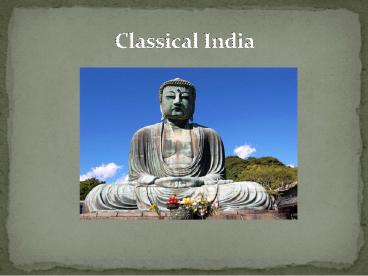Classical India - PowerPoint PPT Presentation
1 / 14
Title:
Classical India
Description:
Epic Age (1000 BCE 600 BCE): Ramayana, Mahabharata and Upanishads created 600 BCE: ... Chapter Three Classical India Author: Rhiannon Ford Last modified by: Whitney – PowerPoint PPT presentation
Number of Views:154
Avg rating:3.0/5.0
Title: Classical India
1
Classical India
2
Geography of India
- Most of India separated from rest of Asia
subcontinent. - Himalayas in N and NE linked India to the Middle
East. - 2 important agricultural regions Indus and
Ganges River regions.
3
Aryans and the Vedic Age
- Aryan (Indo-European) hunter-gatherer migrants
came from central Asia to India. - Vedic Age (1500-1000 BCE) Indian agriculture
flourishes in Indus and Ganges Rivers. - Epic Age (1000 BCE 600 BCE) Ramayana,
Mahabharata and Upanishads created - 600 BCE India divided into 16 states
- Sanskrit literary language of Vedic culture
- Religious texts Vedas
- Indian Caste System began as Indian social
classes
4
Indian Caste System
- Brahmins - priests
- Kshatriyas - warriors
- Vaisyas - merchants, traders
- Sudras - artisans, farmers
- Harijan Untouchables, outside of the caste
system, - Castes were hereditary only marry within castes,
and could not move out of your caste in your
lifetime. - Hindu process of reincarnation moves the physical
body up or down - Aryans developed caste systems because they saw
themselves as superior, and wanted to distinguish
themselves from non-Aryans.
5
Mauryan Empire (322 BCE-185 BCE)
- 327 BCE Alexander the Great of Macedonia
expanded to the Indus River Valley, where he set
up a state named Bactria. - Threatens Indian communities (Aryans
non-Aryans) - 322 BCE Mauryan Empire founded by a soldier
named Chandragupta Maurya to protect Indian
territory. - Unify much of India by developing a large
bureaucracy and a large army. - Promoted trade and communication.
- Mauryan rulers were the first to unify most of
the Indian subcontinent. - Mauryans rule using political centralization
6
Ashoka's Rule
- Ashoka was the most prominent Mauryan ruler
(269-232 BCE) - Extended Mauryan territory, gaining control of
all but southern tip of India. - Known for brutality, but later converts to
Buddhism and becomes peaceful. - Spreads Buddhism throughout the subcontinent
continued to tolerate Hinduism. - Improved trade routes that connected India to
Silk Roads constructed extensive road system - Indian cultural influence spread widely because
of trade and Buddhism, especially in Southeast
Asia.
7
Kushans (30 CE 375 CE)
- After Ashokas death, Mauryan empire began to
fall apart - Regional kingdoms surfaced.
- Kushans invade central India from NW
- Greatest Kushan king, Kanishka, converted to
Buddhism but this hurt Buddhisms popularity in
India by associating it with foreign rule.
8
Guptas (320 CE 550 CE)
- Guptas established a large empire in 320 CE an
era of political stability. - Guptas are Hindus caste system and influence of
Brahmins spread. - Buddhism was still tolerated Buddhist monks and
nuns spread religion beyond India through
monasteries and trade routes. - Gupta political system was decentralized local
rulers could maintain authority in their
respective territories if they ultimately
submitted to Guptas.
9
Gupta Golden Age
- Religion
- Stupas in honor of Buddha courtyards, paintings,
sculptures - Lavish Hindu wall paintings and carving in caves
(Ajanta) - Literature
- Growth of Sanskrit as the language of the
educated - Huge output of epic poems
10
Gupta Golden Age, cont.
- Education
- University at Nalanda lecture halls, library,
observatory - Math
- Discovery of zero and development of Arabic
numerals - Decimal system negative numbers square roots
- Science
- Indian scientists borrowed from Greek learning
via contact with Alexander the Greats Bactria. - Sterilization during surgery and in treatment of
wounds. - Knowledge of plastic surgery and setting of
bones. - Advances in astronomy (eclipses, identification
of planets) - Circumference of the earth theory of gravity
- Strengthening of trade, especially between E and
SE Asia
11
Gupta Decline
- By 500, Gupta India were invaded by the White
Huns. - Other nomads drove further into central India.
- Simultaneously, the influence of Gupta rulers was
in decline as local princes became more powerful. - Similar to what occurred within Zhou China
- 600 CE, India fragmented into regional states
ruled by princes (Rajput). - Although political decline occurred as a result
of invasions, traditional Indian culture
continued. - Buddhism became less popular, while Hinduism
added to its followers.
12
Hinduism and Buddhism
- Hinduism (religion of majority)
- Developed gradually over many centuries
- Sacred texts Vedas
- No founder, no central holy figure
- Buddhism
- Developed in 563 BCE after Siddhartha Gautama,
who becomes the Buddha (enlightened one) - Buddha accepted many Hindu beliefs but rejected
its priests and the caste system it supported. - Buddhism didnt stick in India despite Ashokas
conversion, but spread throughout Asia
13
Art in India
- Stupas spherical Buddhist shrines
- Art was less realistic, and more stylistic
- Art was very colorful and was inspired by
religion.
14
Economy and Society in India
- Caste system
- Created social order by regulating marriages and
dictating rights (lower caste members had fewer
rights) - Family life
- Patriarchal society rights of women limited
sati - System of arranged marriages
- Economy
- Extensive trade both within the subcontinent and
in Indian Ocean trade. - Emphasis on trade (cinnamon, elephants, salt,
fish) - Excelled in iron-making
- Produce textiles, cotton
- Agriculturally based































